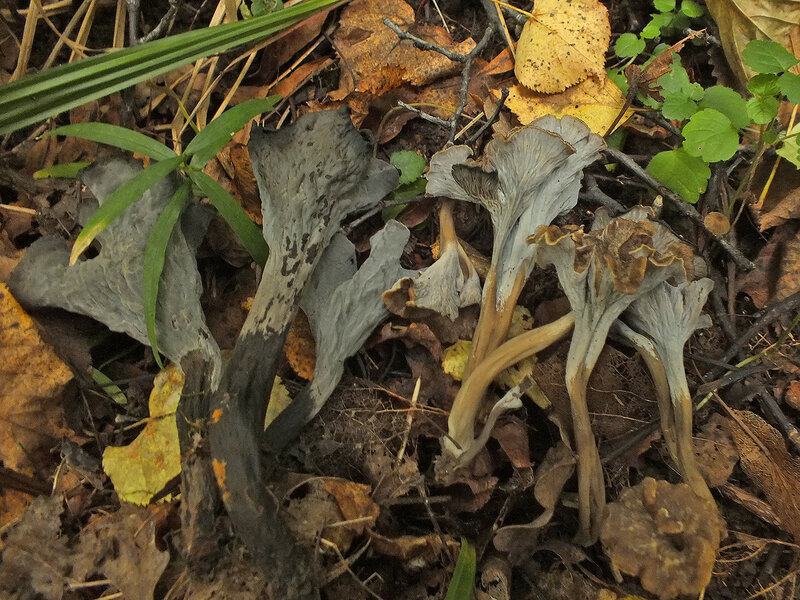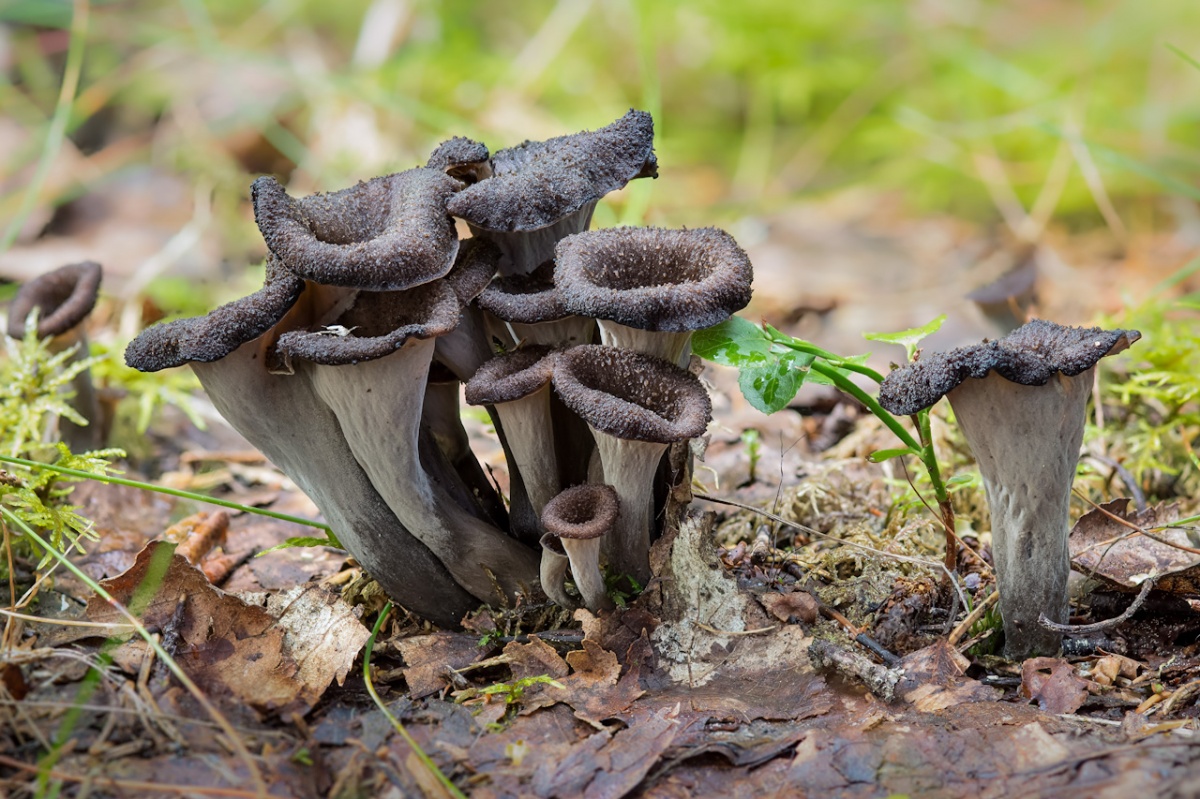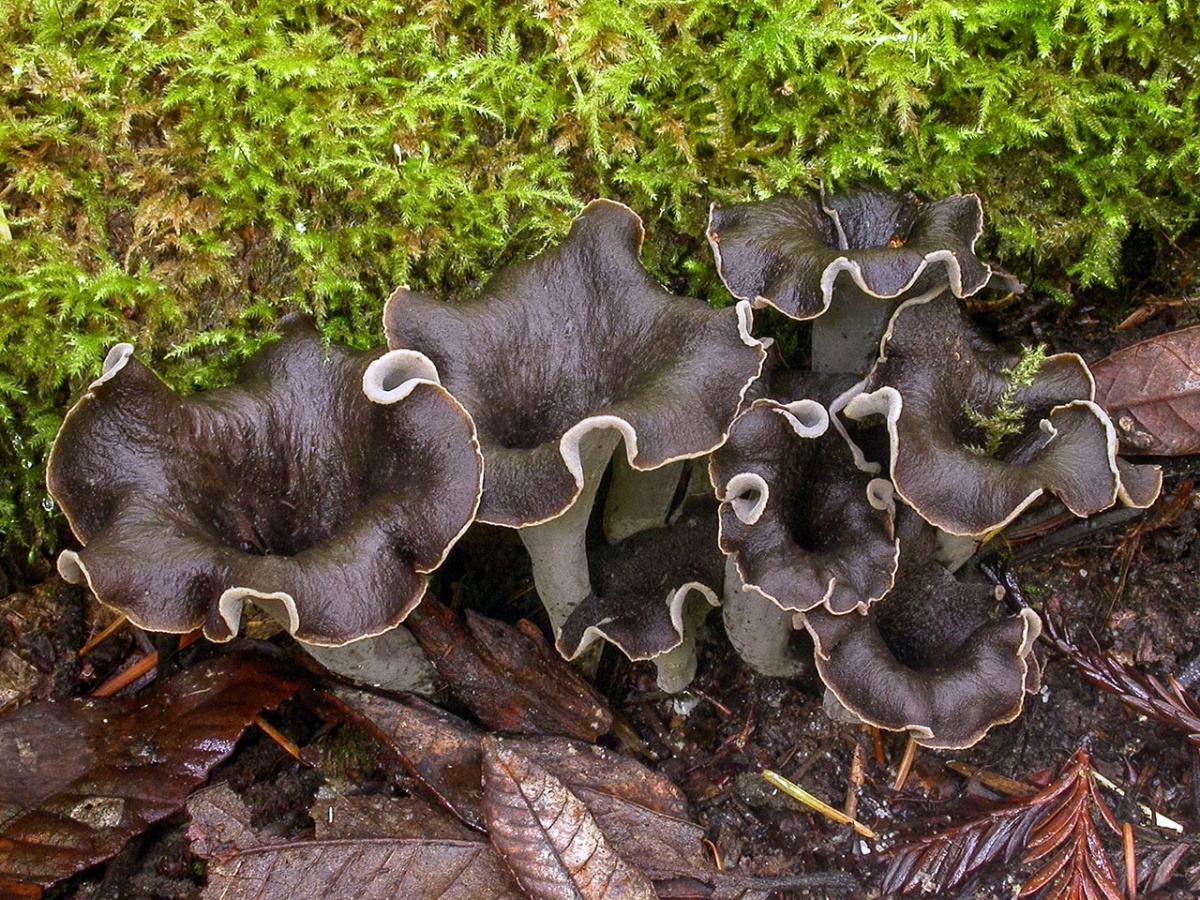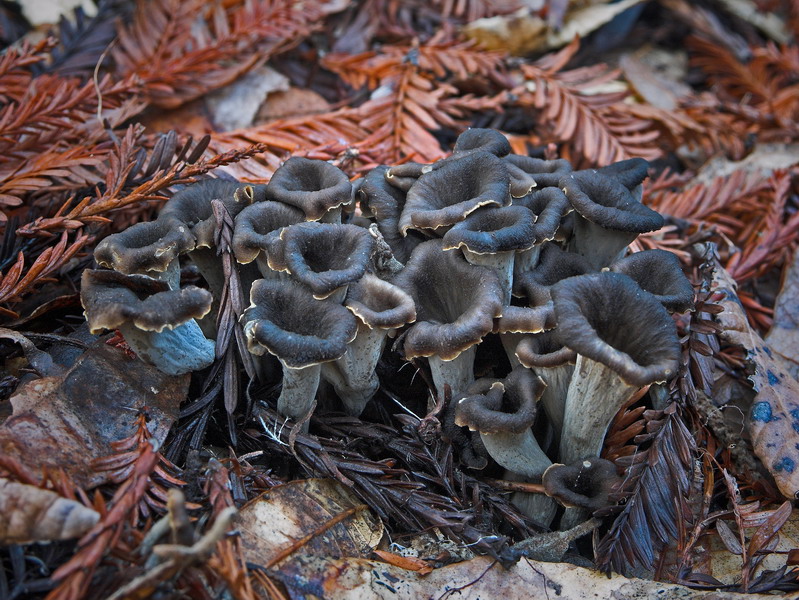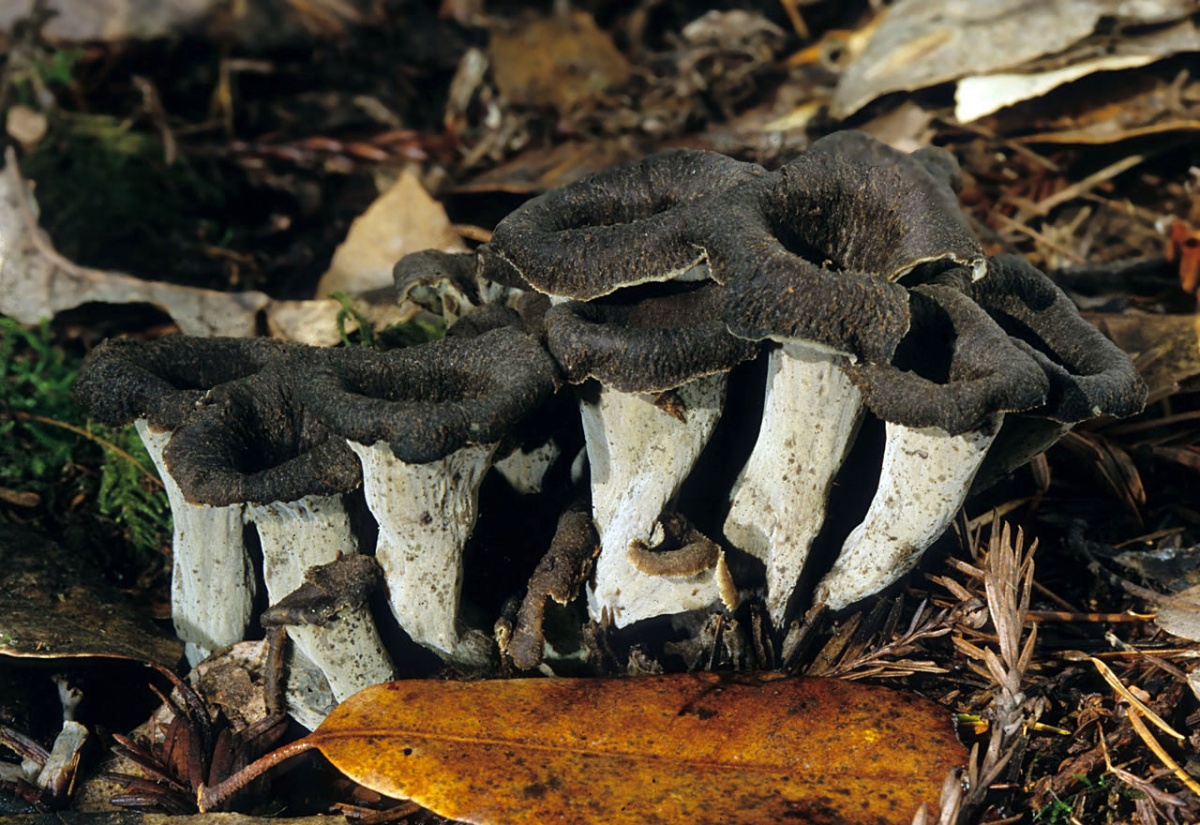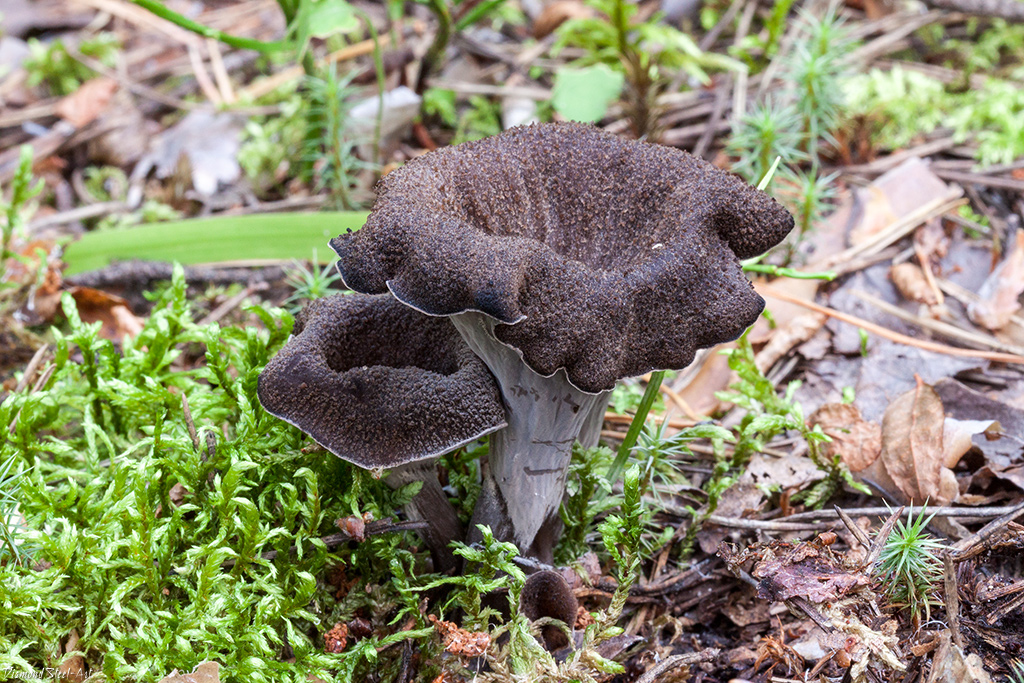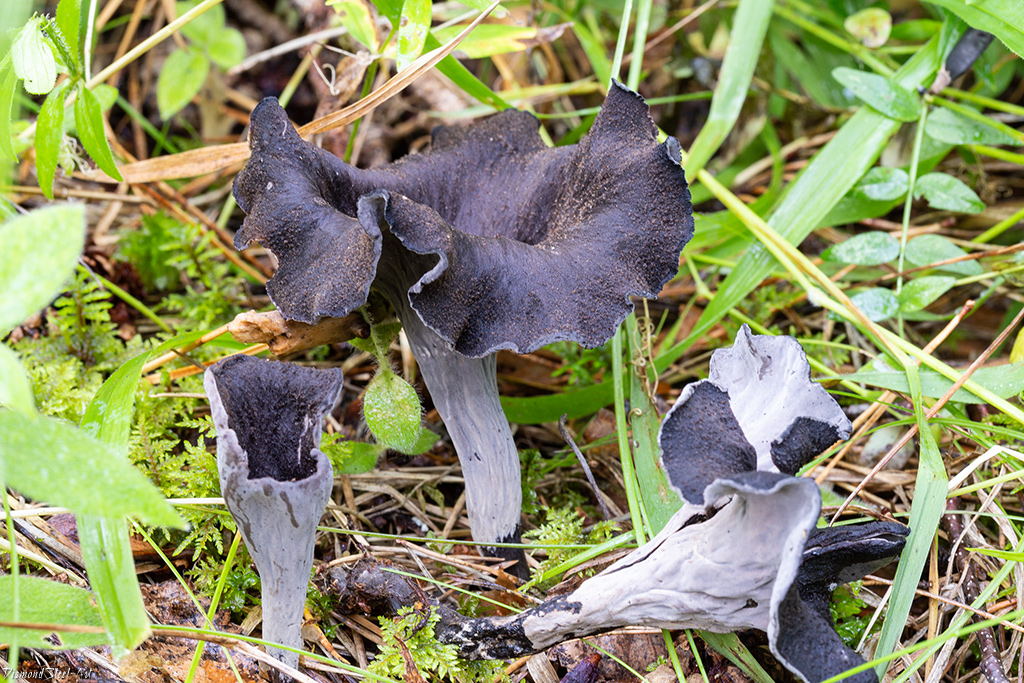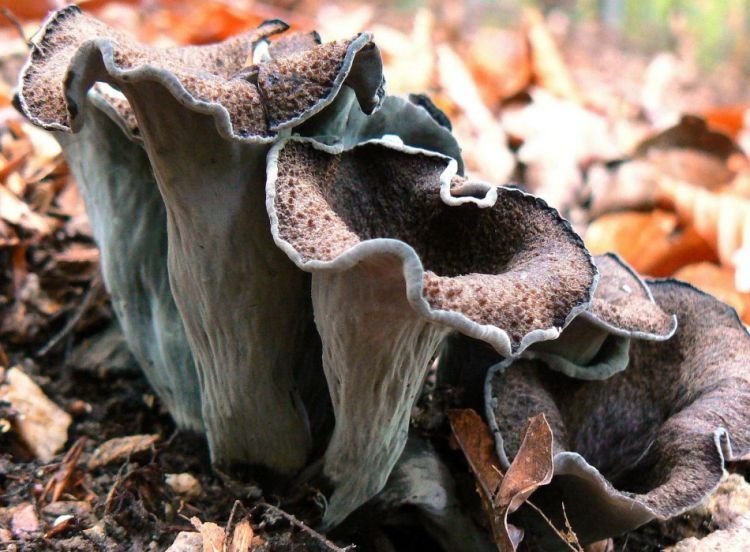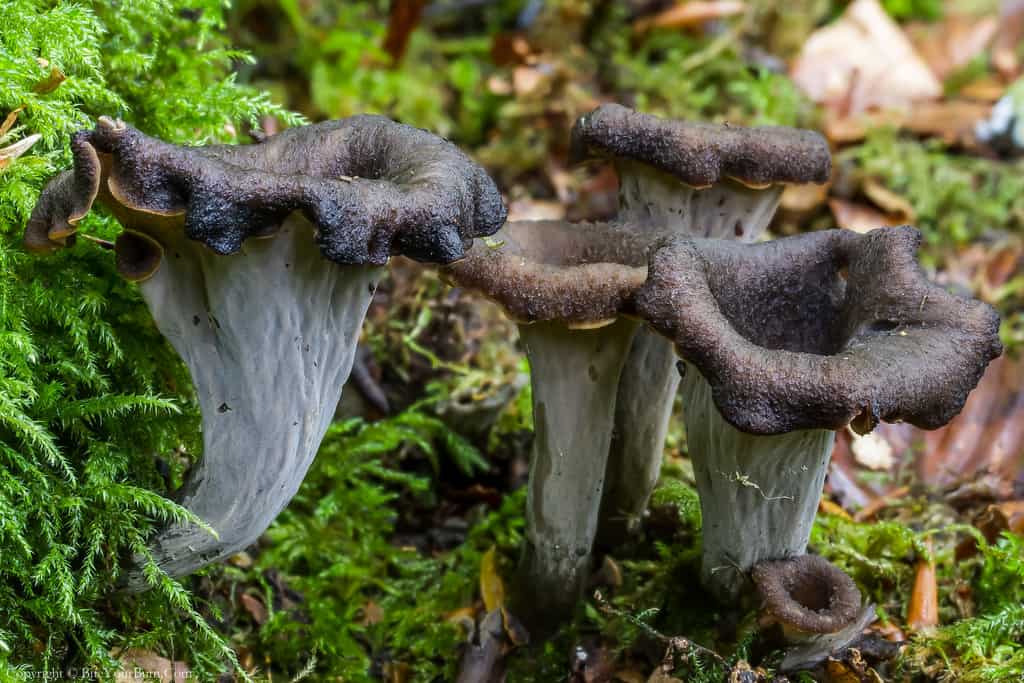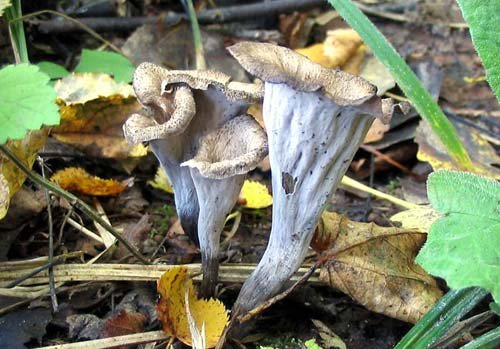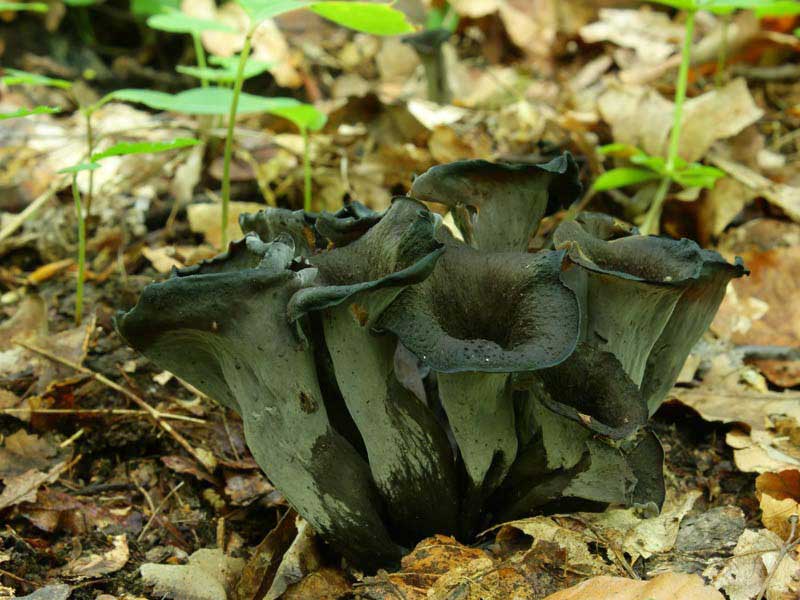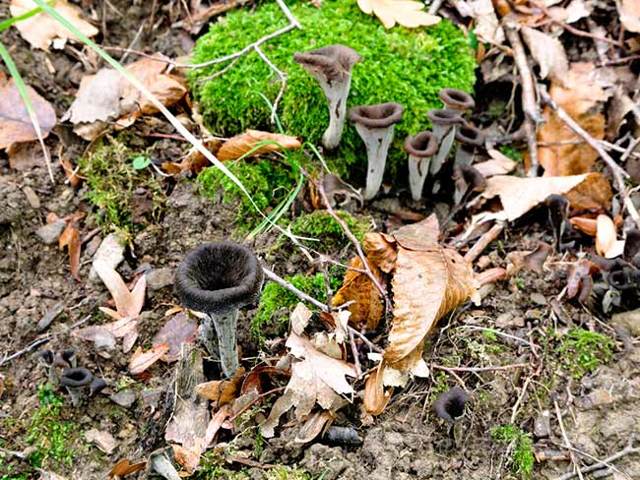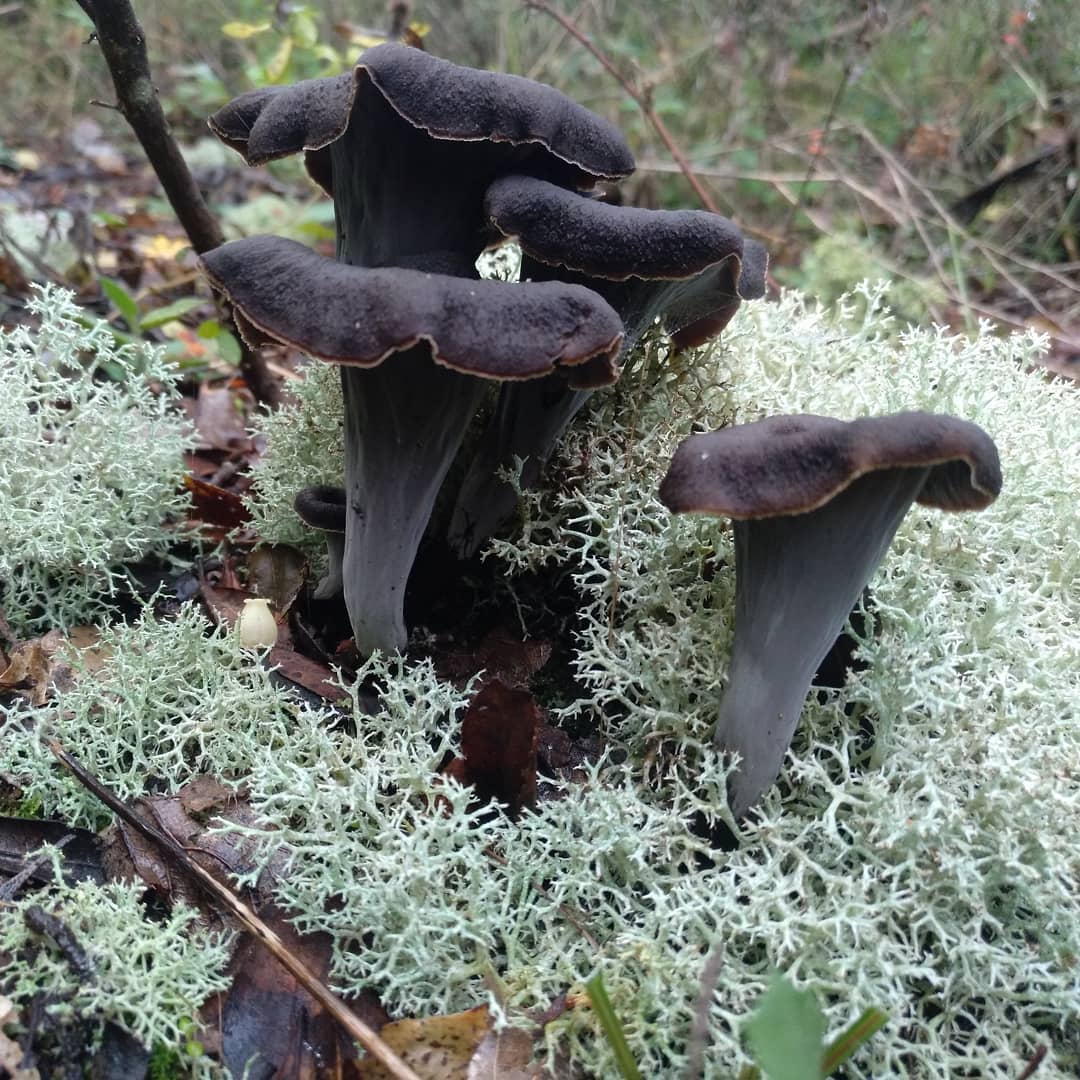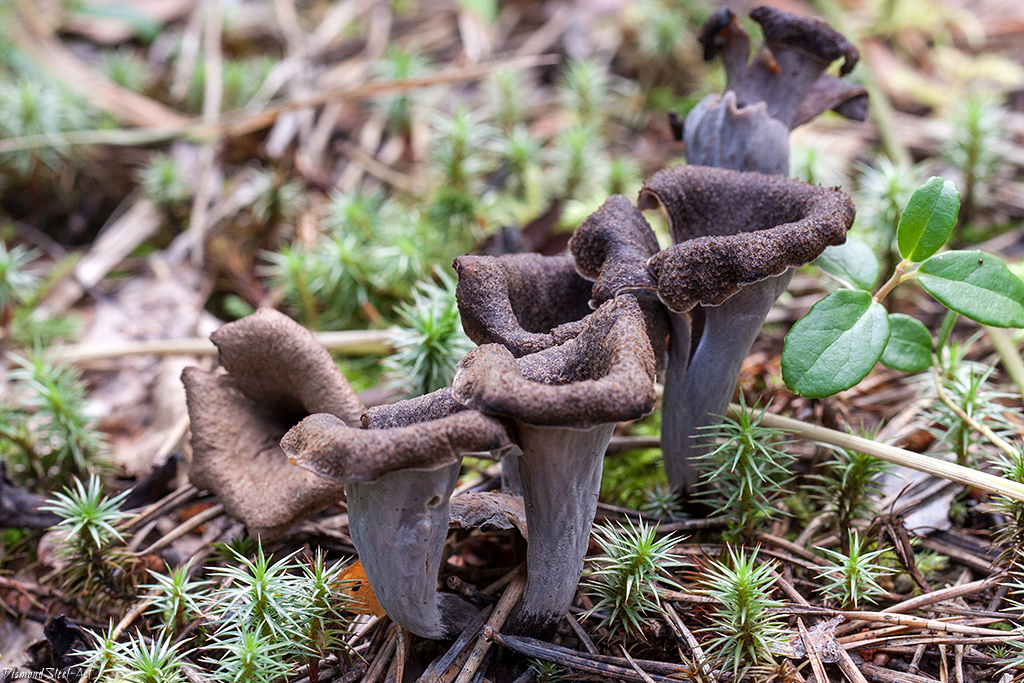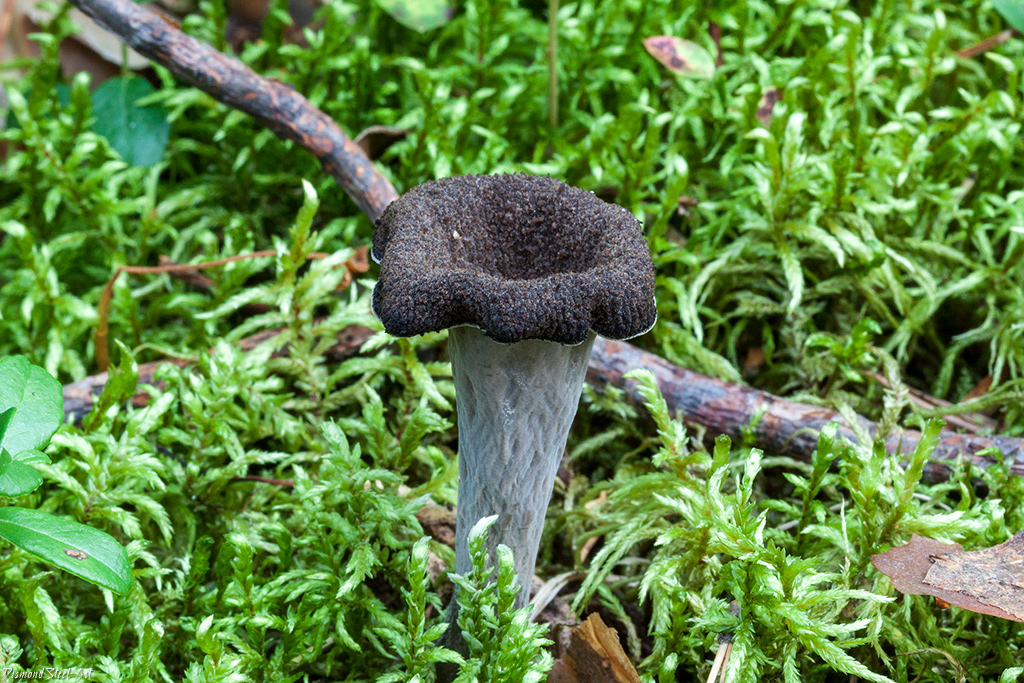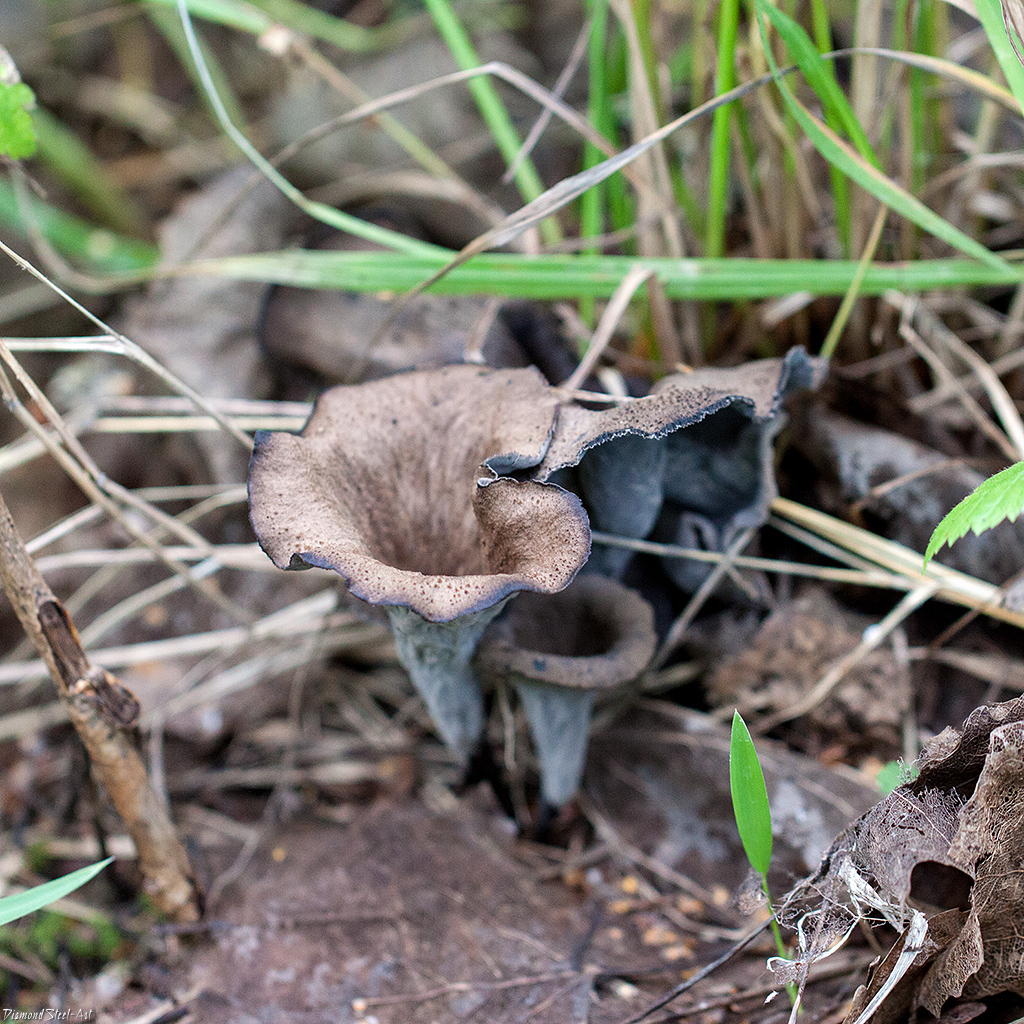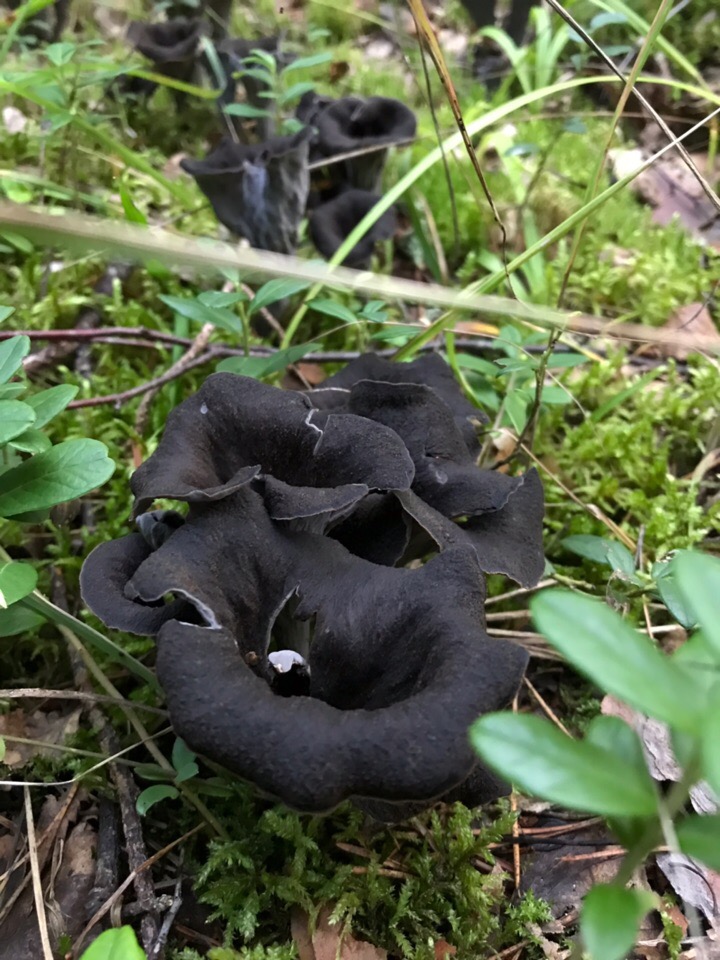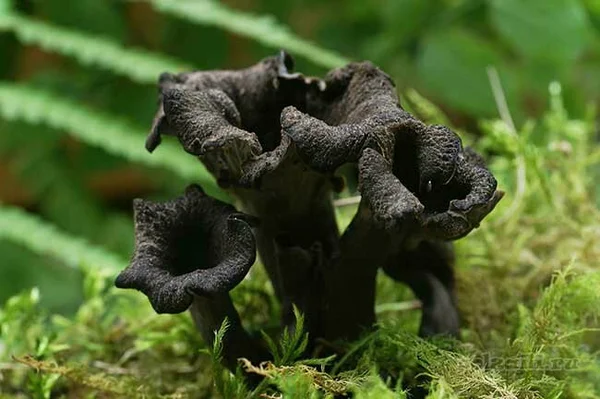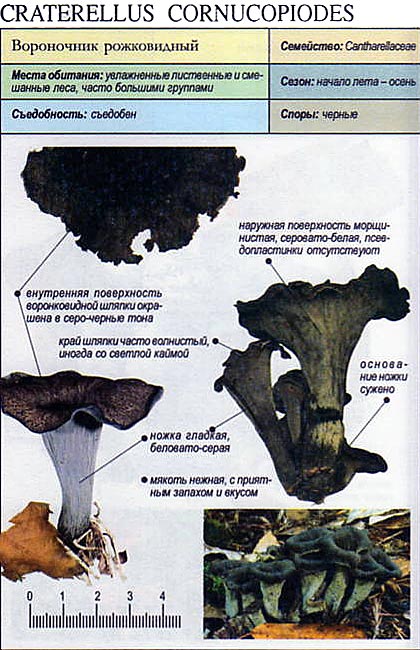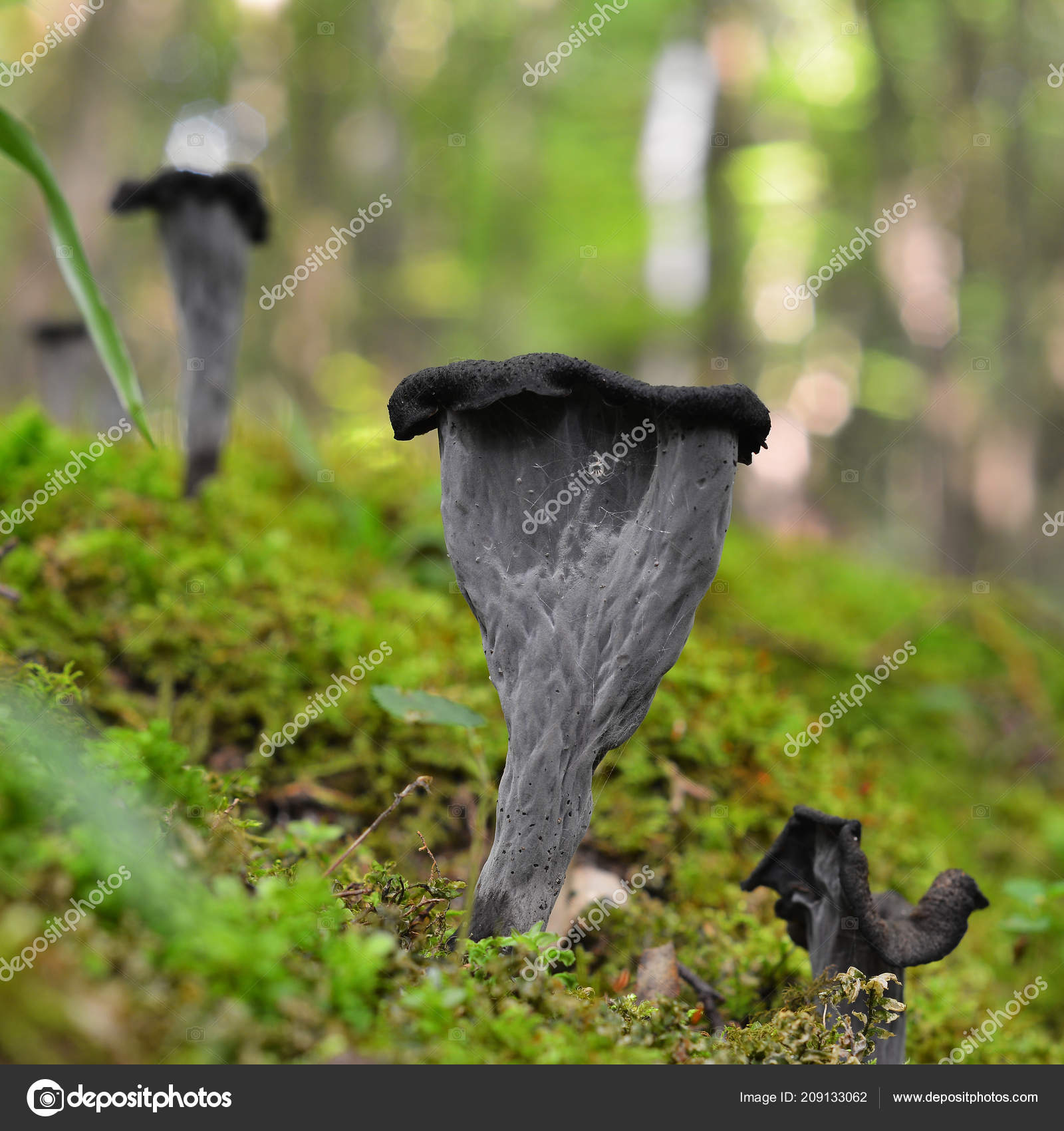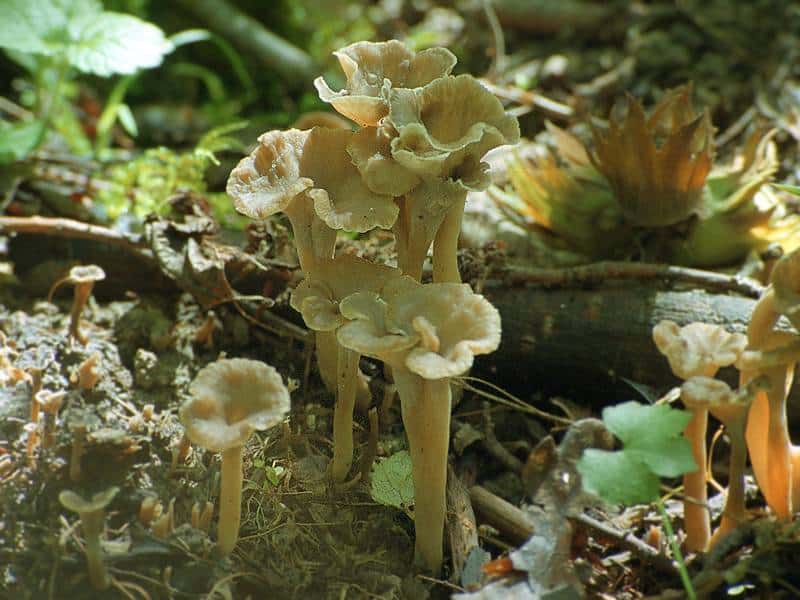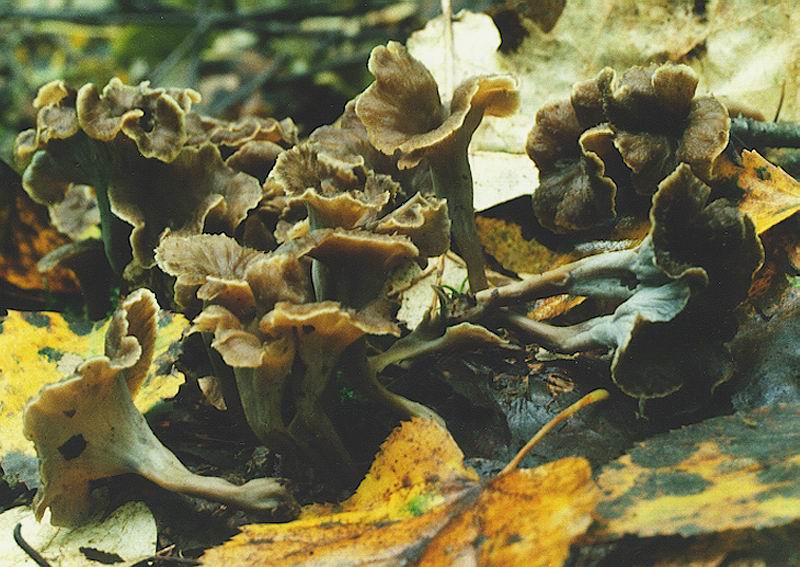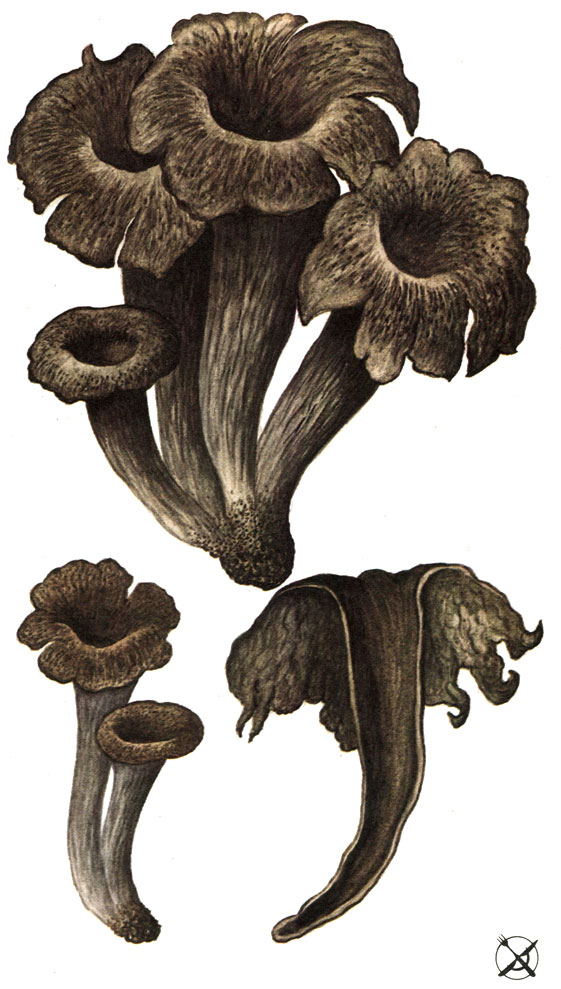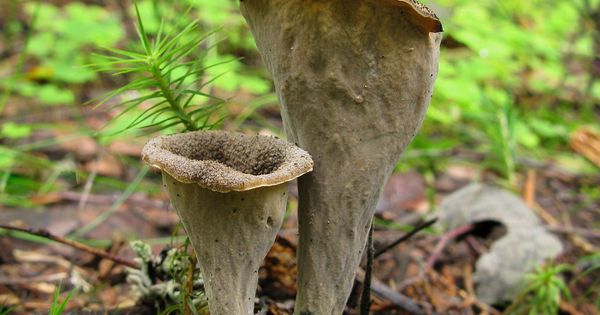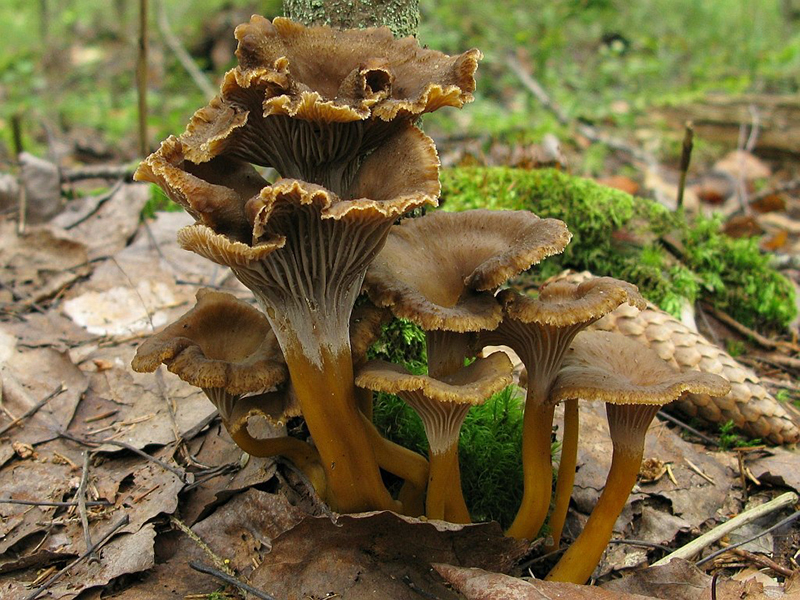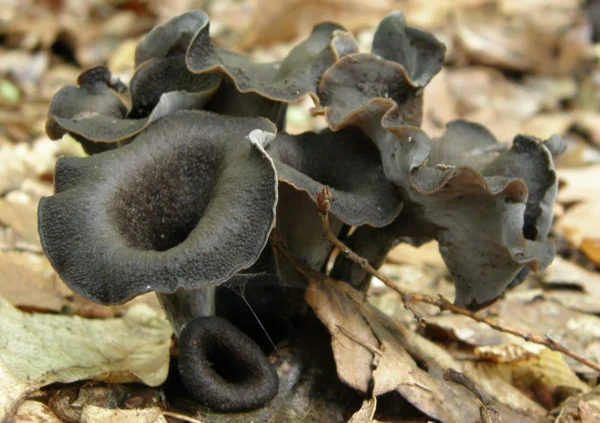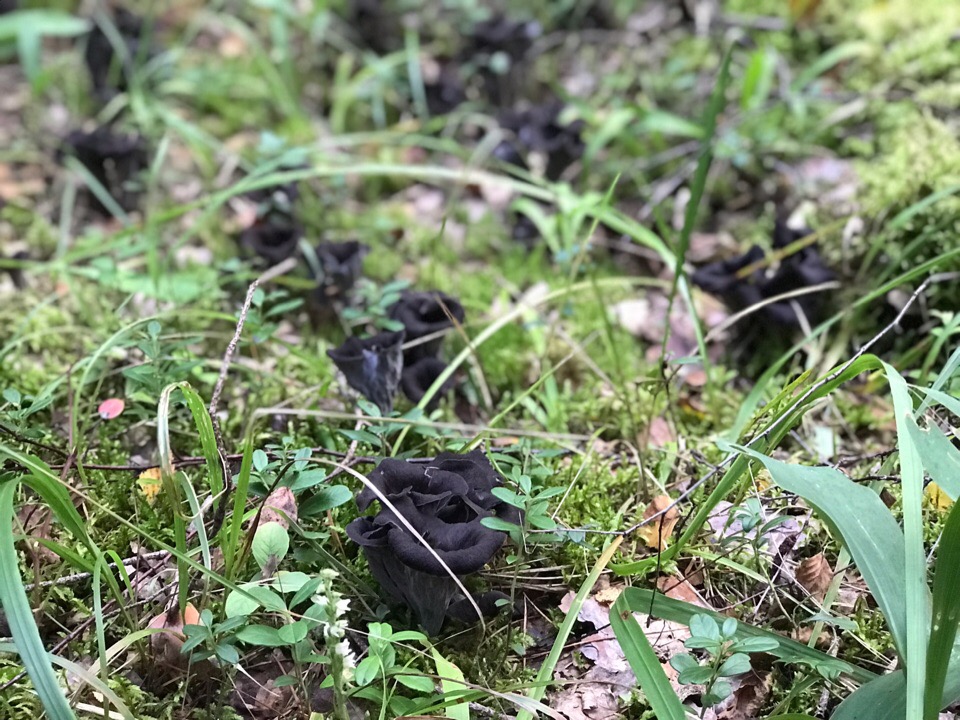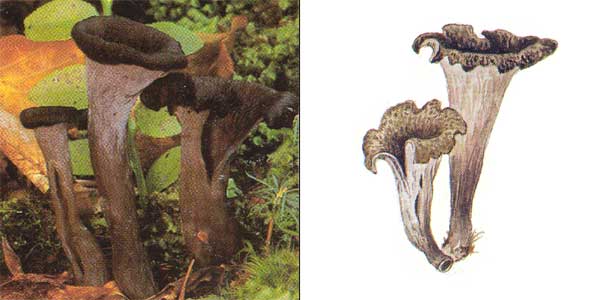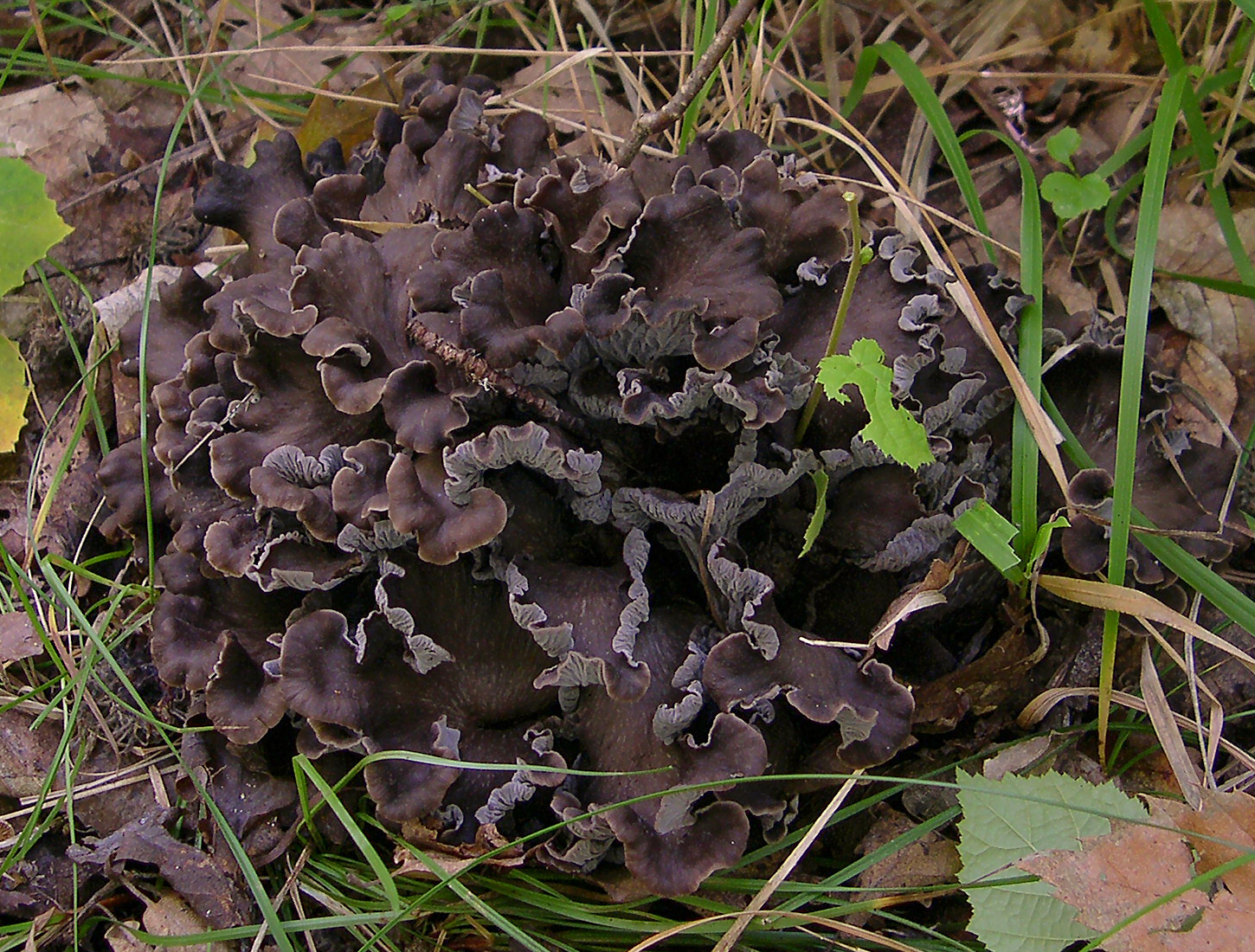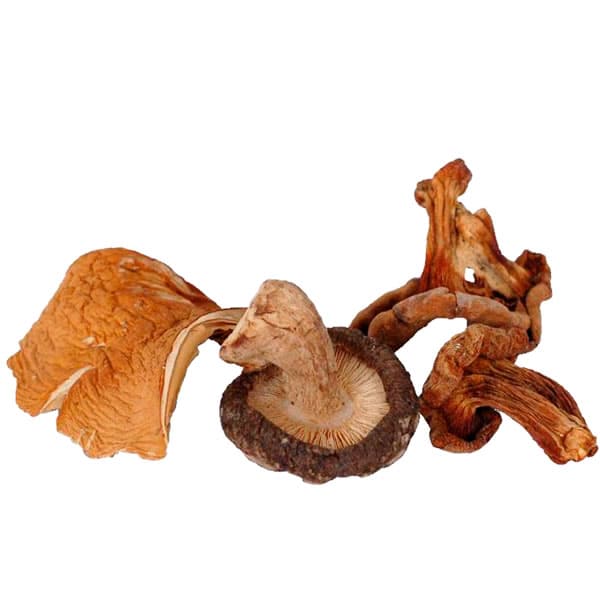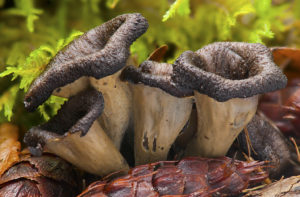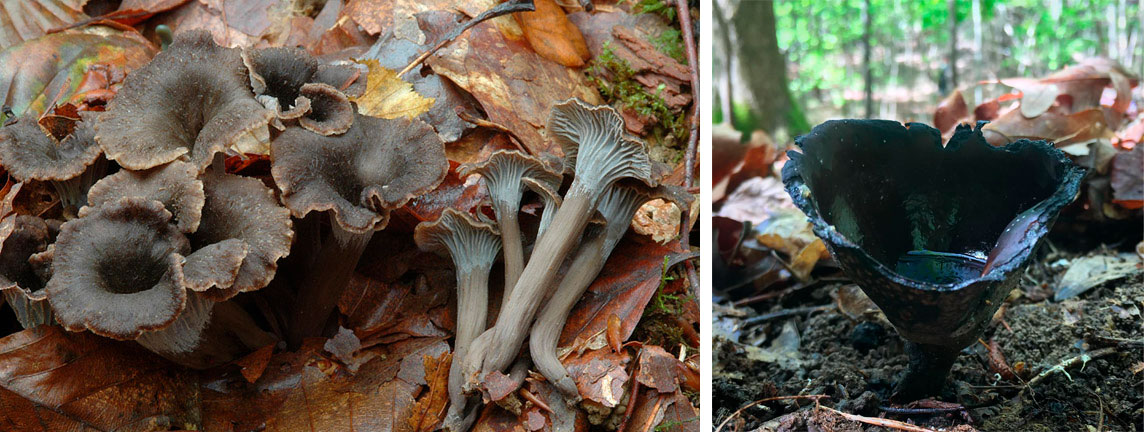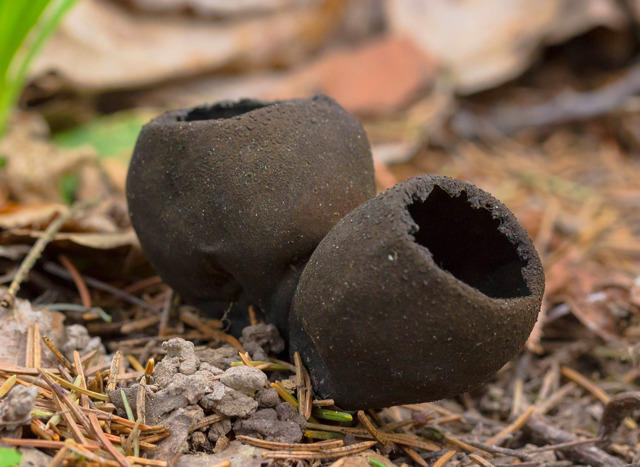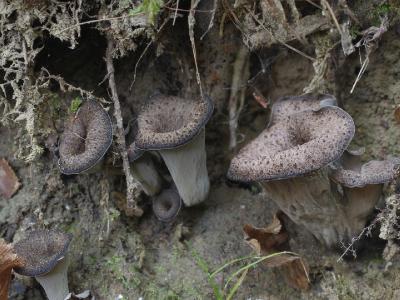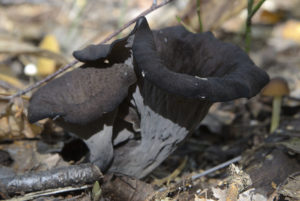Time and place of fruiting of Craterellus hornform
The horned funnel can be found in deciduous and mixed forests of all continents of the Northern Hemisphere. It is found in different climatic zones between the tundra and the tropics. He especially loves mountains and foothills.
Grows well in Europe, including Scandinavia and Finland. In Russia, it is distributed in the European part, Western Siberia, the Far East and in the mountainous regions: in the North Caucasus and in the Altai Territory.
The best symbionts of the horned trumpet mushroom are beeches and oaks, but they are also found under birches and other deciduous trees, sometimes under spruces. Prefers calcareous and clayey soils, places - open, light. It can often be found near the roadside.
The horny pipe mushroom begins to bear fruit in July, but is found in greatest numbers in Russia from mid-August to the end of September. In warmer countries, the peak of growth is shifted a little further along the calendar - until mid-October-November.
Horn-shaped funnels, as a rule, are found in groups. But even large clusters of them are not easy to detect: the dark color merges with the ground and fallen leaves.
Description
The fruiting body of representatives of this species has the shape of a tube or bowl, which becomes narrower closer to the base. The height of the mushrooms ranges from 5 to 12 cm. They are hollow inside. The cap has a depression that smoothly goes into the cavity of the mushroom stem.
The funnel cap has a funnel shape. Its diameter is small, on average 4-8 cm, the edge of the cap is wavy, it is slightly turned outward. In an adult mushroom, it breaks or has blades. The inner surface has a fibrous structure, covered with small scales. In young specimens, it has a dark brown color, and in adult fungi it becomes gray or even almost black.
In this case, the outer surface is painted brown with a slightly grayish tint. Young fruiting bodies have a smooth gray hymenium, and with age they are lumpy or slightly wrinkled. It has a gray tint. After the spores have matured, this surface looks dusted. When the body of the fungus dries up, it takes on a lighter shade. Sometimes in nature you can see light yellow horn-shaped funnels, which used to belong to a separate species.
Representatives of this species do not have pseudo-plates, which are a characteristic feature of chanterelles. The color of the spore powder is white or slightly yellowish. The leg of these mushrooms is short, its thickness is slightly less than 1 cm. At the base, it is narrowed, stiff to the touch. The hat and the leg are the same shade.
They have fragile flesh. At first, mushrooms are distinguished by dark gray flesh, and adult specimens are almost black. It is noteworthy that raw mushrooms have almost no smell and taste. They become more pronounced after drying or cooking.
conical morel - description of where it grows, the poisonousness of the mushroom
Funnelmaker recipes
Cleaning
The first step in preparing mushrooms is to clean them. This must be done by hand, pre-soaking the mushrooms in cold water for 15-20 minutes. After that, put the funnel on a dry surface and cut off the leg with a sharp knife, while trying not to damage the cap, which can be wiped with a special sponge.
With this mushroom, you can prepare a variety of delicious and varied dishes. They will be an excellent addition to meat.
Meat with mushrooms and creamy sauce
What you need:
- pork fillet - 0.5 kg;
- heavy cream 30-33% - 200 ml;
- funnel mushroom - 300-400 gr;
- carrots - 2 pcs;
- rice flour - 20 gr;
- coconut or butter - 50 ml;
- spices.
Initially, fry the carrots in oil; if you wish, you can add a lot of onions.
Then cut the pork into small slices. The meat must be fried and vegetables added to it. Mushrooms are cooked separately. They need to be washed well and cut into medium pieces. Then we put the funnel in a saucepan, and then add heavy cream and rice flour to it.
Mix meat and mushrooms in one container and add spices to the finished dish. You can use cauliflower or buckwheat as a side dish.
Freezing
If you have collected too many mushrooms, then they can be frozen. In this case, they will not lose their value and will be stored for a long time.
Only prepared mushrooms need to be frozen, because it will be difficult to clean them after defrosting. It is better to cut the mushrooms into pieces and pack them in small bags. Do not add other vegetables to them when freezing.
Frying
Frying the funnel is simple, it does not need to be thermally pretreated.
Add the peeled and chopped mushrooms to a skillet with oil and fry for 15 minutes over medium heat.
Drying
You can dry the funnel in the oven, in the sauna room, or on the windowsill in a sunny place. But if you do it wrong, the result will be unsatisfactory. It is better to use a special apparatus for this, which thoroughly dry the mushrooms. The most common dryer designed for vegetables will do. It has several tiers, so a large number of funnel hoppers can fit there.
After the mushrooms are dried, they need to be transferred to a cloth bag. This will help prevent bacteria from developing. Remove the required amount of funnel as needed.
(2 assessments, the average: 5.00 out of 5)
The benefits of black chanterelles
Chanterelle mushrooms, shown in the photo in the previous sections, according to the description of their composition, have healing properties. Due to this, they are used in medicine. Prepare alcoholic tinctures, powder based on horn-shaped funnel, as well as oil extracts. The widespread use of mushrooms is based on their beneficial properties:
- anti-inflammatory;
- immunostimulating;
- bactericidal;
- anthelmintic;
- antineoplastic and some others.
Black chanterelles accumulate many trace elements. Marked: zinc, selenium, copper. The mushroom contains some amino acids, vitamins of groups A, B, PP. Thanks to this set, they contribute to the restoration of vision. The substances in their composition have a positive effect on the mucous membrane of the eyes, contribute to its hydration. Prevents the onset and development of eye infections. Their use can be considered as the prevention of eye diseases.
Preparations based on black chanterelles help to strengthen the nervous system, enrich the blood with hemoglobin. It is used to treat liver diseases, in particular hepatitis C.
Advice! Eating black chanterelles promotes weight loss as they contain negligible amounts of protein.
Chinomannosis, which contains black chanterelles, is used in the treatment of tonsillitis, boils and abscesses, helminthiasis. The substance also delays the development of tuberculosis by acting on the causative agent of the disease.
Mushrooms are beneficial for people with diabetes. The enzymes in the chanterelle stimulate the cells of the pancreas to regenerate.
However, there are contraindications to the use of the horn-shaped funnel. Among them are marked:
- allergy;
- age up to 5 years;
- period of pregnancy;
- breastfeeding period;
- inflammatory processes of the digestive system;
- pancreatitis.
Funnel mushroom - description
The unusual mushrooms in the photo met me in early September in a spruce-birch forest. But the funnel mushroom also lives in deciduous and mixed forests, in oak forests, in beech forests. It can also be found in a pine forest, but not in a pure lichen pine forest, but in a green moss forest with an admixture of spruce and deciduous species. It often grows along roads, paths, and does not like dense thickets.
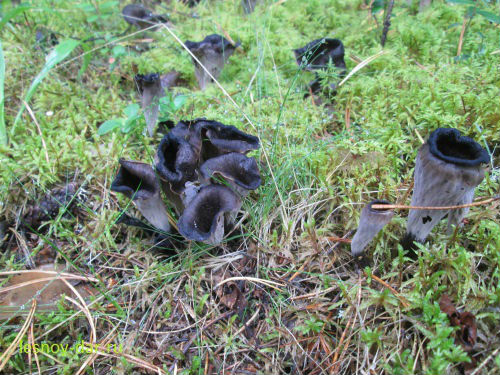
Funnel mushrooms by the road in a pine forest
The fungus is widespread throughout the world, its range is almost the entire forest zone of the Northern Hemisphere. The horn-shaped funnel is common in Europe, including the European part of Russia. In the North Caucasus and Altai, the mushroom can also be found in the mountains. The forests of Western Siberia, forests and mountains of the Far East, Japan, the North American continent - the mushroom is widespread everywhere. Such a cosmopolitan ...
Meanwhile, the funnel mushroom is not well known. Perhaps because it is inconspicuous and does not strike the eye. Its dark gray or almost black fruiting bodies often merge in color with the darkened foliage of last year. Plus, the mushroom isn't that big. Usually its height is no more than 10 centimeters, and the diameter of the cap is from 3 to 5 centimeters, rarely more.

The funnel mushroom is most like a pipe or horn.
But if you nevertheless pay attention to the strange glasses scattered through the forest, gathered in groups on the forest lawn, then in the structure of their fruit bodies you can see a number of curious features. There are a lot of mushrooms with funnel-shaped fruiting bodies
But it is funnel-shaped, that is, similar to a funnel. But look closely at the funnel. Its fruiting body is a real funnel, because the recess on the cap goes into the cavity of the leg. The edges of the cap are bent, and in adult mushrooms they are torn into shreds
There are a lot of mushrooms with funnel-shaped fruiting bodies. But it is funnel-shaped, that is, similar to a funnel. But look closely at the funnel. Its fruiting body is a real funnel, because the recess on the cap goes into the cavity of the leg. The edges of the cap are bent, and in adult mushrooms they are torn into shreds.
The top side of the cap is inside the funnel. It is covered with small scales, dark gray, sometimes brown, often almost black. The lower, outer side of young mushrooms is smooth and gray, in adults it is slightly wrinkled, grayish. Here, the hymenium fungus is a layer in which spores mature. When they are ripe, the outside will become dusty.

The underside of the funnel mushroom is ash gray and slightly wrinkled
Description of the horn-shaped funnel
The fruit body of the horn-shaped funnel is cupped or tube-shaped. The length of the mushroom reaches 5-12 centimeters. The leg tapers towards the base. The mushroom is hollow, the indentation in the cap goes into the leg.
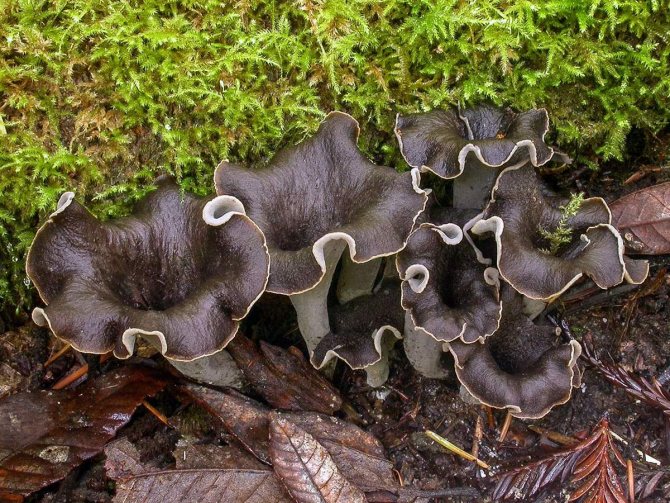
The hat looks like a deep funnel with a diameter of 3-8 centimeters. The edges of the cap are wavy, turned outward. The edges of mature mushrooms become lobed and wavy.
The inner surface of the fruiting body is fibrous with small scales. In young mushrooms, it is black-brown, and in adults it is dark gray, almost black. The outer surface of the horn-shaped funnel is grayish-brown. In young mushrooms, it is covered with lumpy hymenium of a bluish or grayish hue, and when the spores mature, it looks powdered.
When the mushroom dries up, its color becomes lighter. Sometimes there are light yellow specimens, earlier these mushrooms were considered a separate species of Craterellus konradii.
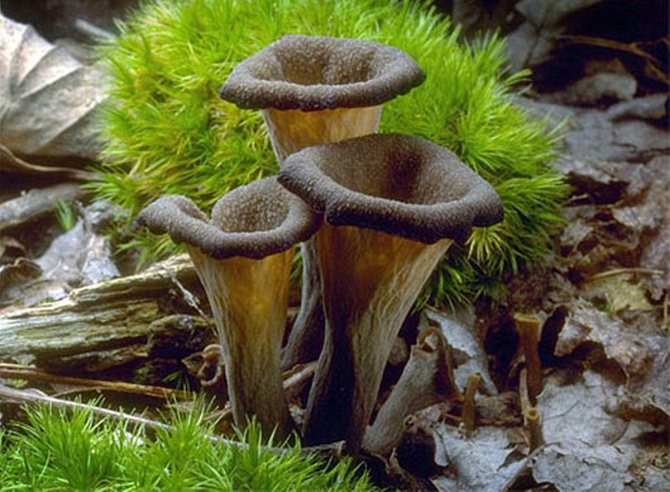
The horn-shaped funnel does not have pseudo-plates, which are characteristic of chanterelles. Spore powder, yellowish or white. Spores are smooth, ovate-ellipsoidal, colorless.
The leg of the horn-shaped funnel is very short, its thickness is 0.8-1 cm. The color of the leg is the same as that of the cap.
The flesh of the horn-shaped funnel is fragile, very thin. In young specimens, the flesh is dark gray, black-brown and gray-black, while in adults it is almost black.
Places of growth of the horned funnel
The horn-shaped funnel is a mycorrhizal fungus, that is, it forms an association with the roots of higher plants. They grow in moist mixed and deciduous forests. On limestone and clay soil next to beeches and oaks and on fallen leaves.
These mushrooms prefer bright and open areas such as roadsides and ditch edges. In mountainous areas, horn-shaped funnels are common mushrooms.
They are widespread in the temperate regions of the Northern Hemisphere to the tropics, in Asia, including Japan, in Europe and North America. In our country, the horn-shaped funnel is found in the European part, in Western Siberia, in the Far East, Altai Territory and the North Caucasus.
Cathedral harvest time
Horn-shaped funnels are most often found in crowded groups, while more than 4 specimens grow together, they can also form rather large colonies. These mushrooms have a camouflage color, so they merge with leaf litter, so it is not easy to notice them.
The harvest season is July-September, with peak growth in mid-August and mid-September. In places with snowless warm winters, horn-shaped funnels can be seen until November.
Related species
The horn-shaped funnel is easy to distinguish from related species due to its dark color, cupped shape and the fact that specimens grow in groups.
A related species of the horn-shaped funnel is the sinuous funnel, which has a lighter yellowish color and a more dissected cap.
The horn-shaped funnel bears a resemblance to the Goblet Urnula. It is a leathery, dense, goblet-shaped mushroom of black color. In contrast to this mushroom, the horn-shaped funnel is more fragile and looks like a bowl with raised edges.
Taste qualities of the horn-shaped funnel
The horn-shaped funnel is an edible mushroom; in Europe it is considered a delicacy. No pre-processing is required. Raw mushrooms have practically no taste and smell, and when dried and heat treated, they become noticeably stronger.
Only the tubular funnel of mushrooms is suitable for food, and the leg is coarser, so it is removed. Horn-shaped funnels are used for the preparation of second courses, soups, sauces and seasonings. During boiling, the color of the mushrooms turns black.
Unlike chanterelles, horn-shaped funnels dry well, but at the same time they become brittle and crumble. A variety of sauces are prepared from dried mushrooms.
The horned funnel mushroom belongs to the Chanterelle family. The mushroom also has other names, for example, gray funnel. It is sometimes called the horny tube fungus. In the people, you can sometimes hear the name gray chanterelle, which is erroneous.
Since the shape of this mushroom is unusual, many names are associated precisely with its appearance. For example, in Finland it is called the black horn. The British call this kind of cornucopia, the French call it the pipe of death. And if you translate the name from German, it will mean "pipe of the dead."
About the names of the funnel mushroom
The funnel mushroom most of all resembles a certain pipe or horn sticking out of the ground. True, the appearance of this "musical instrument" is very frightening. Perhaps that is why the Germans call the mushroom "the pipe of the dead." The British and French are more supportive of the funnelman, they have it - "cornucopia". For the Finns, he is just a "black horn".
In the Russian version, the mushroom is often called "gray chanterelle". But this is, of course, a mistake. What - what, but the funnel does not look like a chanterelle at all! Although it belongs precisely to the chanterelle family. However, the funnel hopper does not have any folds, like a chanterelle. And the chanterelle, although it may have a funnel-shaped hat in adulthood, but never looks like a horn.
Chanterelle gray
There is much more reason to be called gray chanterelle in another fungus from the same family, Cantarellus cinereus.
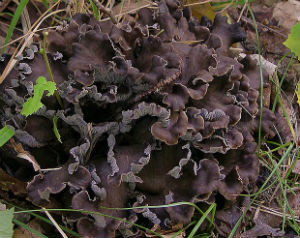
Gray chanterelle (photo from the Internet)
This is a close relative of the common chanterelle, belongs to the same genus. And in the gray chanterelle, the hymenium on the underside of the cap is folded. But the colors of the fruiting body are similar to the colors of the funnel - black top and ash gray bottom. This is probably why there is confusion in the names.
Similar species
The horn-shaped funnel is easily recognizable due to its cupped shape, dark color and tendency to grow in crowded groups. A related species Sinuous funnelhopper (Craterellus sinuosus) (Fr.) Fr.differs from horn-shaped funnel in lighter, yellowish color and more strongly dissected cap. Unlike species of the genus chanterelle (for example, gray chanterelle), the horn-shaped funnel does not have pseudo-plates on the lower surface of the cap.
It also has some similarities with the Goblet Urnula (Urnula craterium) (Schwein.) Fr., a dense leathery goblet mushroom of almost black color. In contrast to it, the funnel is horn-shaped breaking and has the shape of a bowl with a turned-back edge.
Edibility
In our country, the horned funnel belongs to edible mushrooms of the 4th flavor category, but in Western European countries it is considered a delicacy. For mushroom cooking, only the "funnels" themselves are used without rigid base legs. They are cleaned of forest debris and either sent to dry or washed and then used in stews, soups, sauces and stews. The dried "horns" become brittle, easily crushed into powder and used as a seasoning and flavoring agent for appetizing sauces.
Black chanterelles are edible mushrooms with a special shape and dark color, hardly noticeable among the fallen forest foliage. Nevertheless, in the mushroom season, true connoisseurs will surely collect them in an amount sufficient for culinary use and aromatic preparation in dried form.
False doubles
Black chanterelles are perhaps one of the brightest representatives of the mushroom kingdom. It is easy to distinguish from related species due to its dark coloration, cupped shape and the fact that specimens grow in groups. It is rather difficult to confuse this species with others, but it is still worth knowing some possible "doubles".
A related species of the horn-shaped funnel is the sinuous funnel, which has a lighter yellowish color and a dissected cap. This species is somewhat similar to the Goblet Urnula. It is a leathery, dense, goblet-shaped mushroom of black color. In contrast to this species, the black chanterelle is more fragile and looks like a bowl with raised edges.
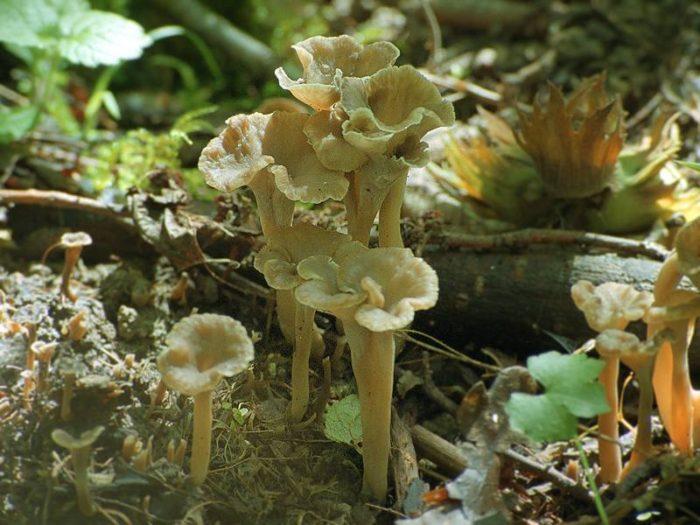 Curvy crow
Curvy crow
Possible harm and contraindications
The horn-shaped funnel is contraindicated in the following cases:
- individual intolerance;
- breast-feeding;
- period of pregnancy;
- children under 8 years old.
As with any kind of mushroom, the black horn should be consumed while it is young. It is forbidden to use old fruit bodies in cooking. There have been cases of people dying after eating edible mushrooms
Therefore, it is important to be aware of the signs of poisoning, which include the following symptoms:
- nausea, vomiting;
- diarrhea;
- abdominal pain.
It is important to pick mushrooms in ecologically clean areas. It is not recommended to buy funnels from your hands
Sometimes they can be found at the grocery store. For 1 kg you will have to pay about a thousand rubles... Mushroom flour in a 330 g container will cost about 1,500 rubles.
Do not pass by the clearing with black horns. It is better to prepare a tasty and healthy dish from them, making sure that the product is safe.
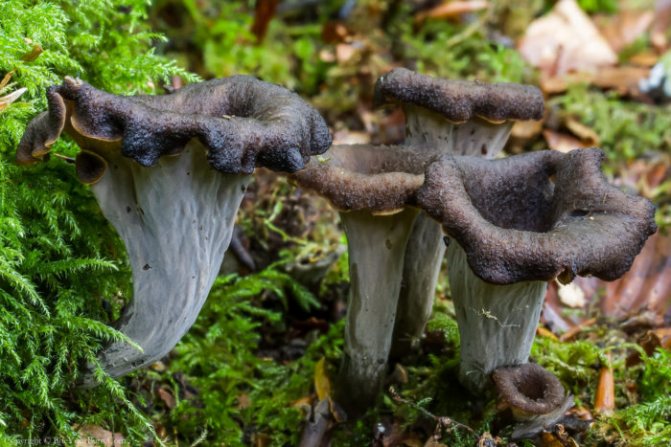
If you do not know for sure, then it is difficult to guess that this black mushroom with a strange bottom surface of the cap can be eaten. However, the horned funnel is not easily edible. In Europe, it is considered a delicacy, calling it "a truffle for the poor." For some reason, it is not in our honor, it is ranked in the IV category for its low taste.
Description of the mushroom
The horn-shaped funnel is also called the Horn-shaped tube mushroom or the funnel-shaped funnel. Sometimes it is called "gray chanterelle", but this is wrong. Finns call it "black horn", British - "cornucopia", Germans and Italians - "pipe of the dead", and French - "pipe of death".
Such gloomy names of the delicious mushroom are explained by its unusual color and fruiting time: in Western Europe, pipe-mushrooms appear in early November, and on the 2nd day is the Day of Remembrance. In Latin, the gloomy gifts of the forest are called Craterellus cornucopioides.
It is not easy to buy a funnel-shaped funnel in Russia: it is a slow-moving product. In dried form, it is sold for 900-1500 rubles. per 100 g, fresh - 13.5-15 thousand rubles. for 1 kg.Black horns are very light, so a kilogram is quite a lot.
Hat
The black, funnel-shaped cap with beautifully curved edges is 5–8 cm in diameter. Older specimens have a ragged edge line, sometimes forming lobes. The upper surface of the cap is dark gray to black, fibrous, scaly. The depression passes into the leg cavity.
Hymenophore

It does not have the usual visible plates or tubes. Gray, wrinkled, the transition to the leg is not pronounced. In old mushrooms, it is covered with an easily removable bluish bloom.
Pulp
Filmy, brittle. In adult specimens it is black, in young specimens it is dark gray. Raw funnel hoppers have practically no funnel-shaped taste and smell.
Leg
Very stiff, short (5 to 12 mm), hollow.
False and poisonous counterparts of Hornbeam Tubes
Most often, the horn-shaped funnel is confused with the chanterelle. Sometimes both are called the Black Chanterelle, although this species does not exist. Funnelhogs and chanterelles are relatives, albeit quite distant: they belong to the same family, but of different genera. It is very simple to distinguish them: the gray chanterelle has pseudo-plates, and the funnel-shaped funnel has no folds, it has wrinkles.
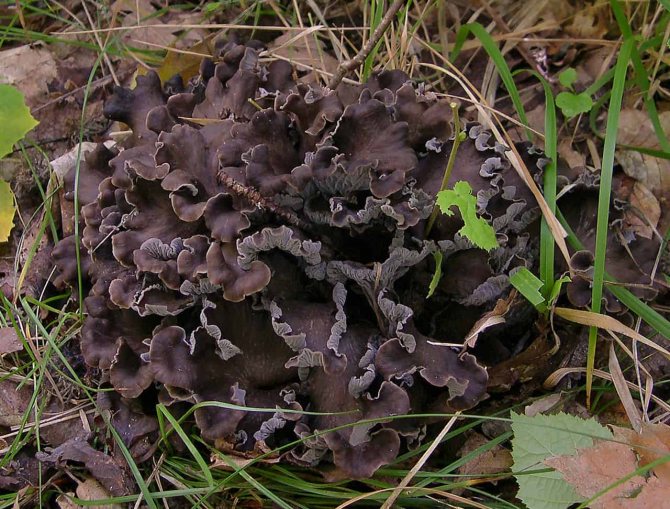
Chanterelle gray
However, both of them are edible, so even if they are confused, nothing unpleasant will happen. The gray chanterelle is considered by some to be tasteless and for this is referred to as conditionally edible mushrooms, but the same is said about the common chanterelle.
There is an opinion that the goblet funnel is similar to the sinuous funnel. But the second one is much smaller (3-5 cm both in height and in diameter) and of a completely different color. Sinuous funnels are also of a darker color, but in this case they have a light rim along the edges of the cap, which you will never find in a horn-shaped one. The sinuous funnel is classified as inedible because of its tastelessness.

Sinuous funnel
Somewhat similar to the funnel-shaped funnel-shaped Urnula goblet. It is inedible due to its unpleasant taste. In contrast to the urnula, the flesh of the horn-shaped trumpet-mushroom is brittle, and the edges of the cap are turned away. It looks more like a chanterelle, and the head of the goblet urnula resembles a cognac glass.

Urnula goblet
Until recently, the funnel-shaped funnel-shaped Craterellus cornucopioides and its North American cousin Craterellus fallax were considered different species and even found a difference in their gastronomic quality. However, genetics put an end to the controversy between the cooks, and now there is no need to describe the completely insignificant difference between these forms, which turned out to be genetically identical at the species level.
Horn-shaped funnel (lat.Craterellus cornucopioides)
Name The funnel is horn-shaped.Latin name: Craterellus cornucopioides.Other names: Cantarellus horn-shaped, funnel-shaped funnel-shaped, horn-shaped tube mushroomDepartment: Basidiomycota.Class: Agaricomycetes.Order: Chanterelle.Family: Chanterelle.Genus: Funnelman.Edible mushroom.
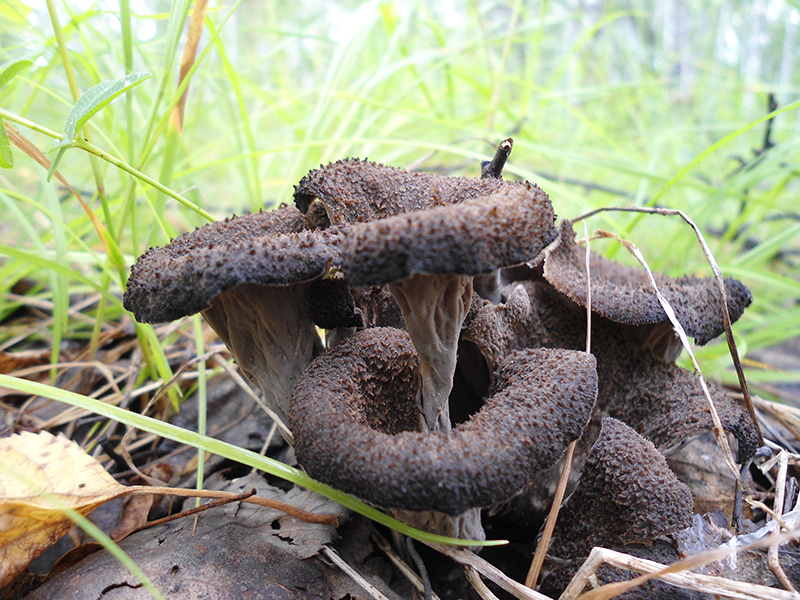 Name The funnel is horn-shaped.Latin name: Craterellus cornucopioides.Other names: Cantarellus horn-shaped, funnel-shaped funnel-shaped, horn-shaped tube mushroomDepartment: Basidiomycota.Class: Agaricomycetes.Order: Chanterelle.Family: Chanterelle.Genus: Funnel maker.Edible mushroom.
Name The funnel is horn-shaped.Latin name: Craterellus cornucopioides.Other names: Cantarellus horn-shaped, funnel-shaped funnel-shaped, horn-shaped tube mushroomDepartment: Basidiomycota.Class: Agaricomycetes.Order: Chanterelle.Family: Chanterelle.Genus: Funnel maker.Edible mushroom.
The lower part of the fruiting body is 45-125 mm long, hollow, narrowed downwards, turns into a cap upwards, gray-brown.
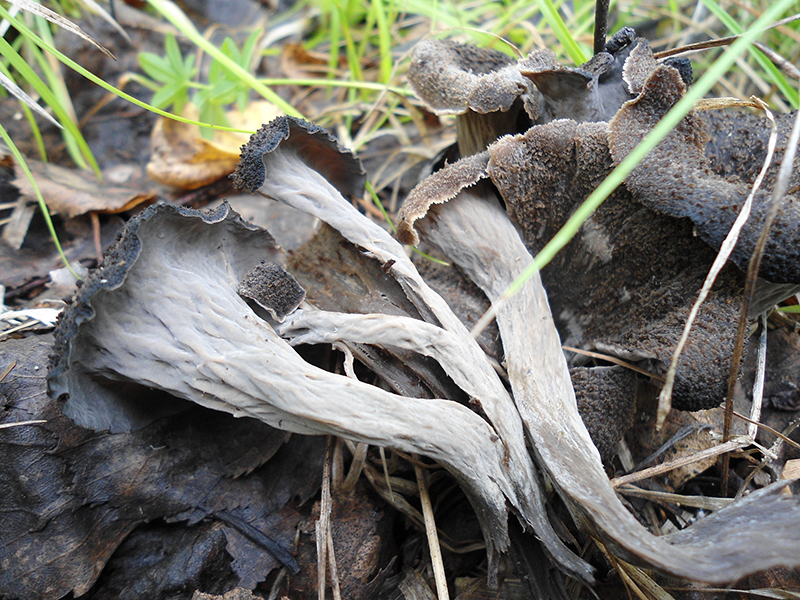
Hat
The upper expanded part in the form of a cap has a diameter of 25-85 mm, in the form of a deep funnel with an uneven edge, it can be wavy or lobed. On the inside, young fruit bodies are black-brown in color; as they ripen, they become dark gray and black, covered with flakes.
Hymenophore
Hymen is smooth at first, then becomes slightly wrinkled, gray in color, at maturity due to spores with a mealy bloom.
Pulp
Very fragile, thin, at first gray-black, later black. The taste is inexpressive and the smell is pleasant. Dried mushrooms are always black and crumble easily.

Habitat
It grows on the soil, as a rule, in numerous groups, in large bunches of several fruit chalk.It is found both in mixed and deciduous forests, birch groves, often at the edges or edges of the forest. The fungus is photophilous and does not like darkened and damp areas of the forest.
Similarity
The horn-shaped funnel has no twins, it is similar to some related species, but the similarity is minimal and it is rather difficult to confuse them.
|
December |
January |
February |
|
March |
April |
May |
|
June |
July |
August |
|
September |
October |
November |
The nutritional value
The mushroom is very aromatic and tasty, but is often ignored by mushroom pickers because of its thin pulp, but it is used in various dishes mainly as a seasoning after drying.

